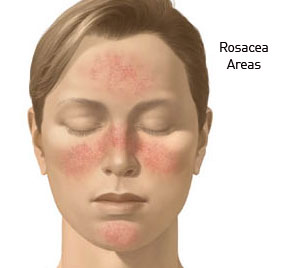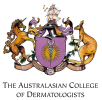Rosacea (pronounced rose ay shah) is a disease affecting primarily the skin of the face. People with very fair skin are most susceptible to this condition. It develops slowly over time.
Patients with rosacea experience:
- A permanently reddened face
- Pimples on the cheeks, chin and nose
- Flaky skin
- Extreme flushing responses to sun exposure, spicy foods, alcohol or hot drinks
- Easily irritated facial skin
- Eye dryness and irritation
- Swelling of other areas of the face, particularly eyelids and nose
- ‘Broken capillaries’
What causes Rosacea?
The cause of rosacea is unknown. Various theories have suggested that rosacea is caused by bacteria, mites, a fungus, a malfunction of connective tissue under the skin or psychological factors. It seems likely that there is no single cause of rosacea and that it develops in individuals who are susceptible due to a variety of factors such as heredity, skin colour and structure.
How does Rosacea Develop?
 In most people, the first sign of rosacea is a persistent redness of the face, particularly on the cheeks and nose. This redness is caused by enlarged blood vessels under the skin of the face and looks like a blush or sunburn. The redness gradually becomes permanent and more noticeable. Facial skin may become very dry.
In most people, the first sign of rosacea is a persistent redness of the face, particularly on the cheeks and nose. This redness is caused by enlarged blood vessels under the skin of the face and looks like a blush or sunburn. The redness gradually becomes permanent and more noticeable. Facial skin may become very dry.
As the redness progresses, pimples may appear on the face. These pimples may be small, red, solid bumps (papules) or pus-filled bumps (pustules) that resemble the pimples of teenage acne. Because of this similarity, rosacea has been called ‘adult acne’ or ‘acne rosacea’.
Small blood vessels in the skin of the face may become enlarged so that they are visible. These enlarged blood vessels look like thin red lines and doctors call them telangiectasia.
In some people, especially men, bumps may develop on the nose. As the number of bumps increases, the nose may appear swollen. This condition is called rhinophyma.
The eyes may become involved as rosacea progresses. The lids and mucous membranes can be affected.
Without treatment, the course of rosacea can be progressive with alternating periods of improvement and worsening of the condition.
Can Rosacea be Cured?
Unfortunately, there is no cure for rosacea at present; however, simple treatments can control rosacea and improve the appearance of the skin.
Can Anything Make Rosacea Worse?
There are well-recognised aggravating factors for rosacea. These include consumption of hot liquids, spicy foods or alcohol; being exposed to extremes of heat and cold; exposure to sunlight and stress. In general, actions that produce a facial flushing reaction or irritate facial skin should be avoided.
What Treatments are used for Rosacea?
Medications can be used to control redness and to reduce the number of papules and pustules. Both creams and oral medications may be used. Oral medications are generally required for the pustular component of rosacea. Oral antibacterial medications, such as tetracycline, are commonly used. Widely used topical medications include is metronidazole and azeleic acid.
In most cases, medications may take several weeks to show an effect. In addition, the medication may have to be taken regularly to keep the rosacea under control.
Surgery is a treatment usually reserved for correcting the nose enlargement in people with rhinophyma. Surgery with a fine electric needle or laser may also be used to eliminate enlarged blood vessels.
Specific moisturizers, soaps, sunscreens or other products as needed to improve the condition of the skin may be recommended.
Application of a regular broad-spectrum sunscreen is very important to prevent disease progression.
If you have any questions or concerns about rosacea contact your local doctor, who will arrange for you to see a dermatologist. Contact us today



